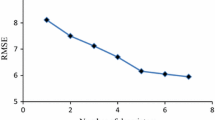Abstract
A back-propagation artificial neural net has been trained to estimate logP values of a large range of organic molecules from the results of AM1 and PM3 semiempirical MO calculations. The input descriptors include molecular properties such as electrostatic potentials, total dipole moments, mean polarizabilities, surfaces, volumes and charges derived from semiempirical calculated gas phase geometries. These properties can be related to the molecule′s solubility in hydrophilic or lipophilic media. The input descriptors were selected with the help of a multiple linear regression analysis. The resulting net estimates the logP values of 105 organic compounds with a standard deviation of 0.53 units from the experimental logP values for AM1 and 0.67 units in the case of PM3.
Similar content being viewed by others
Author information
Authors and Affiliations
Electronic Supplementary Material
Rights and permissions
About this article
Cite this article
Breindl, A., Beck, B., Clark, T. et al. Prediction of the n-Octanol/Water Partition Coefficient, logP, Using a Combination of Semiempirical MO-Calculations and a Neural Network. J Mol Model 3, 142–155 (1997). https://doi.org/10.1007/s008940050027
Received:
Accepted:
Published:
Issue Date:
DOI: https://doi.org/10.1007/s008940050027




